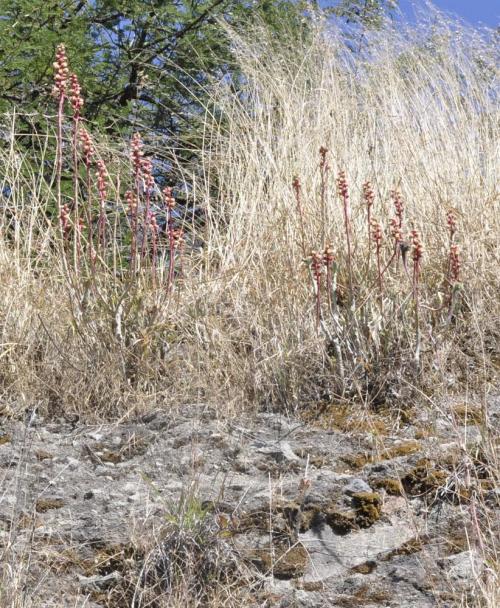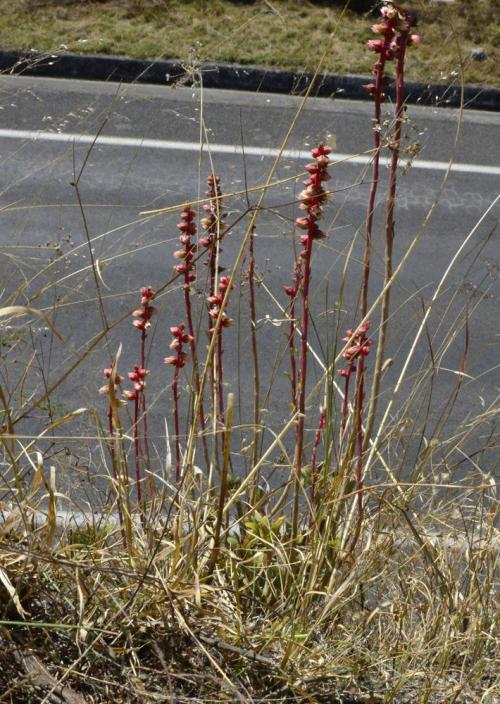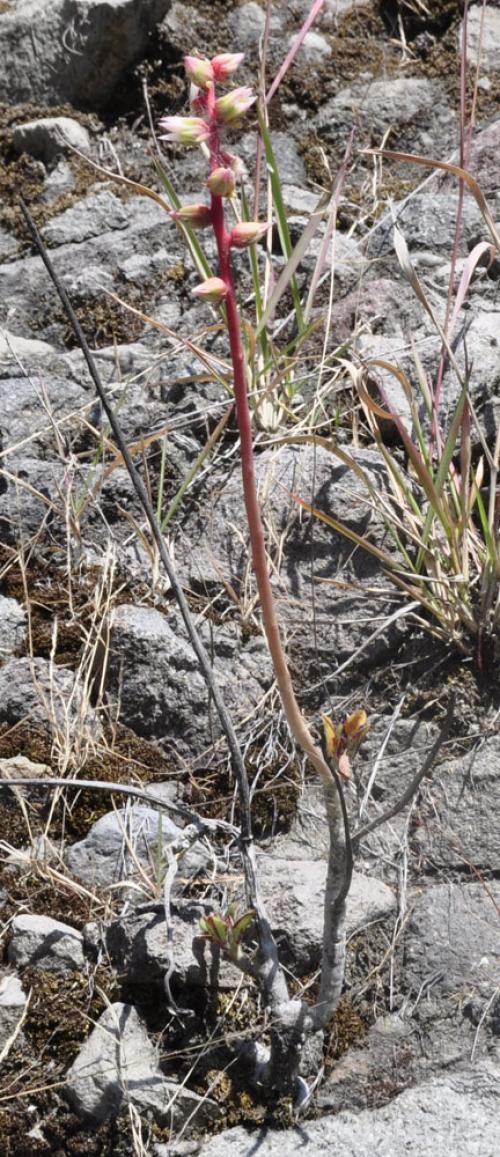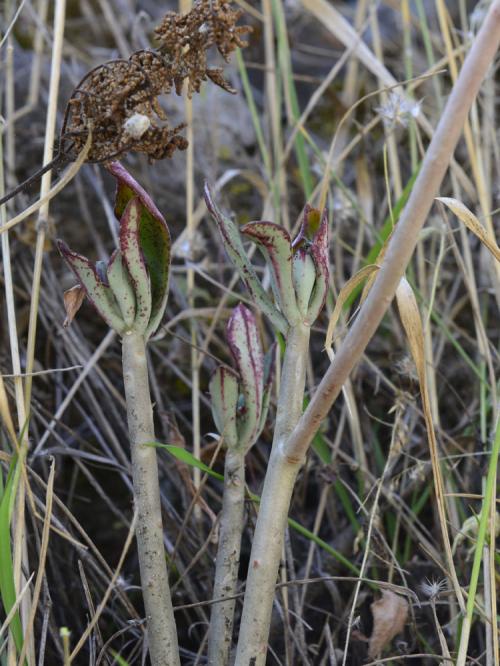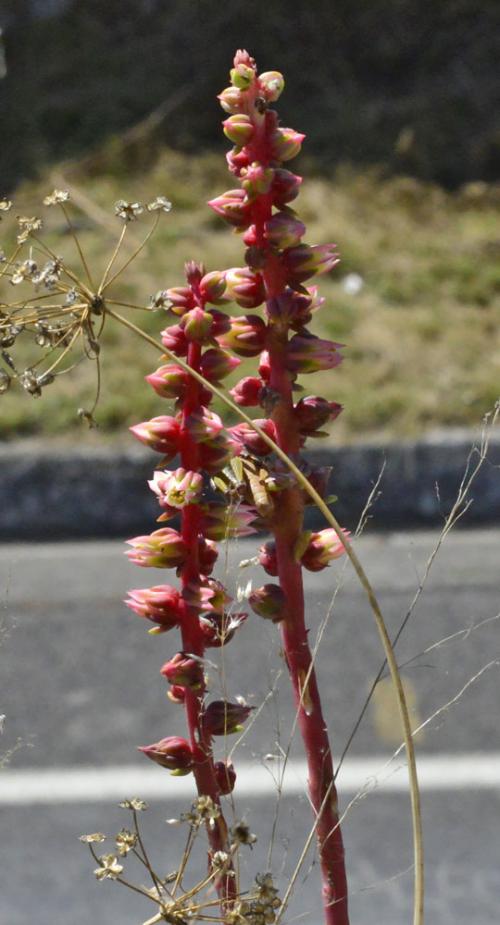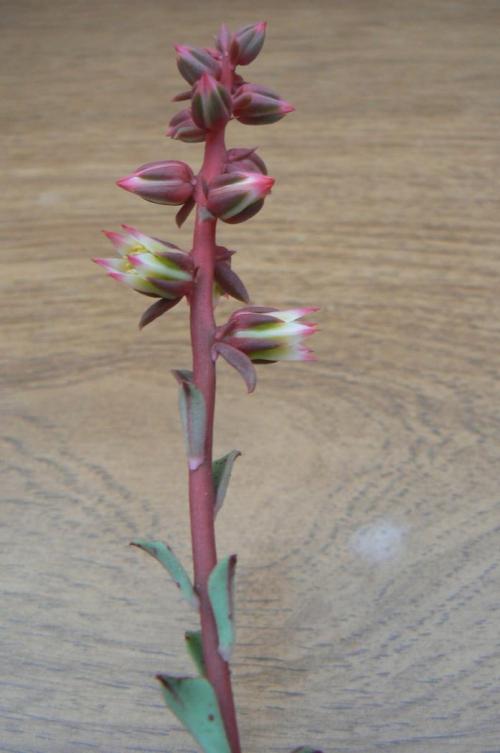WALTHERI Moran & Meyrán, 1961 (engl. / fr.)
Series Nudae
Type : Moran & Kimnach 7695, from Puente de Calderon, 11 km S of villa Guerrero, State of Mexico, at about 1800 m.
Etymology : Reid Moran explains : "This plant was first found by Hernando Sánchez Mejorada. E. Walther took a considerable interest in the plant when he heard of its white flowers. Dr. Meyrán and others of the Mexican society want it named for Eric Walther."
Distribution : Mexico (Guerrero, México).
Description by Reid Moran in Cactaceas y Suculentas Mexicanas, 1961 :
Stems simple or with 1 – 2 branches, erect or in age often sprawling, to 90 cm long, 6 – 14 mm thick, silvery grey green becoming brown, the leaf scars brown, oval, 3 – 5 mm wide, 1 – 3 mm high.
Rosettes lax, of 15 – 25 leaves, the younger crowded at the stem apex, the older scattered below.
Rosette leaves spatulate or often rhombic-spatulate, apiculate, green ventrally, paler dorsally, with edges and keel often red, 3 – 8 cm long, 1 – 3 cm wide, 1.5 – 3 mm thick, flat or faintly channeled ventrally, slightly convex dorsally and obtusely keeled, the margins obtuse, the base subterete, 3 – 4 mm wide, 2 – 3 mm thick.
Floweral stems one or rarely two, at anthesis 1.5 – 7 cm below the stem apex, red above, 25 – 70 cm tall including the inflorescnce, 5 – 8 mm thick at the base, with 20 – 45 spreading to ascending leaves below the inflorescence, the lower leaves similar to those of the rosette, to 6.5 cm long and 2 cm wide, the upper leaves elliptic-oblong, ca 1 cm long.
Inflorescence a spike 5 – 25 cm long, with 10 – 45 flowers, the flowers horizontal or slightly ascending, sessile or the lowermost sometimes on pedicels to 2 mm long and 2 – 4 mm thick. Lateral bracts linear, 4 – 8 mm long, 0.5 – 1.5 mm wide.
Flowers : Calyx 8 – 11 mm long, 8 – 10 mm wide, rounded at the base, the segments appressed to the corolla, slightly unequal, triangular-lanceolate, acute, green to red, separate to the base but not spurred, 8 – 11 mm long, 2.5 – 5 mm wide, corolla 12 – 16 mm long, 6 – 10 mm wide at the base, 4 – 8 mm wide above, greenish white below, the upper third pink or sometimes the keels pink throughout, filaments and pistils greenish white.
Cytology : n = 17.
Link to a summary of the above description in English and French.
Although the species is similar in appearance to E. chapalensis, the chromosome numbers differ fundamentally. Moran & Uhl wrote (see protologue of E. chapalensis):
"On close comparison, the new plant [E. chapalensis] is very similar to E. waltheri, and it agrees quite well in most respects with the original description of that species. Also, Myron Kimnach remarks that it is similar culturally and is equally hard to grow. From present information it seems to be a lower and somewhat more branching plant, with shorter floral stems; but more field observations are needed. However, the calyx and corolla are smooth rather than papillose, and the corolla is more uniformly pink and apparently not gaping.
Although the similarity leaves little doubt that the two plants are related, however, the chromosome number of n = 45 for E. chapalensis is not obviously related to the n = 17 of E. waltheri - see photo below. Since these plants diverged from any common ancestor, their chromosomes must have undergone very extensive reorganization: for it would take a great many rearrangements (e.g. translocations) to bring about such a substantial difference in basic chromosome number. Considering the high crossability of Echeveria species (e.g. see Uhl 1982a), b), the two almost certainly would cross; but their wide geographic separation makes natural hybridization practically impossible. And judging from Uhl's experience in hybridizing Echeveria, the difference in genomes would certainly make any hybrid highly sterile. Thus the two are reproductively isolated and can be called different biological species, which is to say that they are evolving independently of each other, with virtually no possibility of reuniting. Despite their close similitary, therefore, we treat them as different taxonomic species."
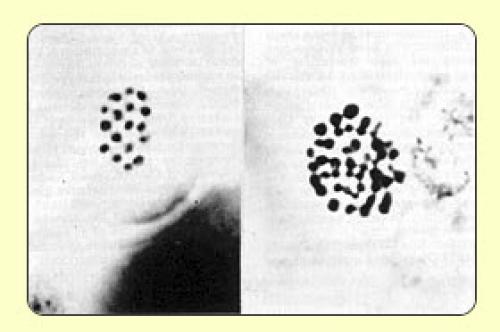
Chromosomes - left of E. waltheri (Moran 7695), right of E. chapalensis (Uhl 2140).
(Taken from the First Description of E. chapalensis.)
